Images of the Mother Goddess in the Neolithic Sanctuary of Pla de Petracos (Alicante, Spain)—The Sacralization of Agriculture
Abstract
:1. Introduction
1.1. Starting Hypothesis
1.2. Methodology: Hermeneutics and Iconological Analysis
1.3. Objectives and Structure
- (1)
- Contextualizing the paintings of Pla de Petracos in the Neolithic society and in the religiosity of the Mother Goddess, as well as in the ritual territory in which they are located and in the material goods excavated in the nearby archeological sites.
- (2)
- Demonstrating—in line with what has been done lately in relation to Palaeolithic Cave Art—that the interpretation of these paintings must be connected, inseparably, with that of the natural ritual environment in which they are located.
- (3)
- To hermeneutically and iconologically analyze the paintings to check if they reflect the general symbols of the Mediterranean Neolithic religions. That is, the objective is to check if Mother Nature is fertile—a vivifying and circular flow—and if it is associated with the stars, the sun, the seed, the sown field, and the bull. Moreover, it is important to reveal the way in which the human being feels co-participation or co-solidarity with the goddess by building a sanctuary.
2. The Social and Sacred Context of the Images of Pla De Petracos
2.1. The Neolithic Society in Alicante (Spain)
2.2. The Mother Goddess, Religion of the Neolithic Mediterranean Societies
3. The Natural and Religious Scenery of the Sanctuary
3.1. The Organization of the Profane and Sacred Spaces of the Ancient Neolithic Communities in the Province of Alicante
3.2. “Cardial” Ceramics, Archeological Material Remains and the Religiosity of the Mother Goddess
3.3. Elements of the Natural and Religious Scenery of Pla de Petracos
3.4. A Sanctuary Where Social Rites Take Place and an Astronomical Observatory, a Marker of Solar Time, through Which Life and Death Pass
4. The Paintings of Pla De Petracos and the Symbolism of the Neolithic Mother Goddess
4.1. The Macroschematic Art and Paintings of Pla de Petracos
4.2. Mother Nature Is Fertile
4.3. Mother Nature Is a Vivifying Flow, Has a Cyclic, Circular Rhythm, and Is Associated with the Stars and the Sun
4.4. Mother Nature Is Associated with the Seed, the Sown Field, and the Bull
4.5. The Mother Goddess or the Cosmic Unity between Humans and Nature
5. Final Coda
Funding
Conflicts of Interest
References
- Álvarez de Miranda, Ángel. 1962. Ritos y Juegos Del Toro. Madrid: Taurus. [Google Scholar]
- Amador Bech, Julio. 1995. Notas acerca de una hermenéutica de la imagen. Revista Mexicana de Ciencias Políticas y Sociales 40: 9–29. [Google Scholar] [CrossRef]
- Arnheim, Rudolf. 1998. El Pensamiento Visual. Barcelona: Paidós. [Google Scholar]
- Atiénzar, Gabriel García. 2011. Las sociedades tribales durante el neolítico inicial en el mediterráneo occidental: Procesos de expansión y consolidación durante el VI milenio (cal. bc). Boletín de Antropología Americana 47: 101–20. [Google Scholar]
- Auban, Joan Bernabeu, Teresa Orozco Köhler, Agustín Díez Castillo, Magdalena Gómez Puche, and Francisco Javier Molina Hernández. 2003. Mas d’Is (Penàguila, Alicante): Aldeas y recintos monumentales del neolítico inicial en el valle del Serpis. Trabajos de Prehistoria 60: 39–59. [Google Scholar]
- Bataille, George. 1981. La Parte Maldita. Barcelona: Icaria. [Google Scholar]
- Beltrán Villalba, Miguel. 2016. Dramaturgia y Hermenéutica: Para entender la Realidad Social. Madrid: CIS-Centro de Investigaciones Sociológicas. [Google Scholar]
- Blair, Sheila S., and Jonathan M. Bloom. 1999. Arte y Arquitectura del Islam 1250–1800. Madrid: Cátedra. [Google Scholar]
- Boehm, Gottfried. 1978. Zu einer Hermeneutik des Bildes. In Seminar: Die Hermeneutik und die Wissenschaften. Hrsg. von H-G. Gadamer und G. Boehm. Frankfurt am Main: Suhrkamp Verlag, pp. 444–71. [Google Scholar]
- Bouleau, Charles. 1996. Tramas. La Geometría Secreta de los Pintores. Madrid: Akal. [Google Scholar]
- Bradley, Richard. 1997. Death by water: Boats and footprints in the rock arc of western Sweden. Oxford Journal of Archaeology 16: 315–24. [Google Scholar] [CrossRef]
- Bru Romo, Margarita. 1990. La mujer en el arte prehistórico. Simbología y Representación. In Actas de las Terceras Jornadas de Investigación Interdisciplinar. Madrid: Universidad Autónoma de Madrid, Ediciones de la Universidad Autónoma de Madrid. [Google Scholar]
- Campbell, Joseph. 1992. Diosas. Girona: Atalanta. [Google Scholar]
- Campbell, Joseph. 2015. Las Máscaras de Dios: Mitología Occidental. Madrid: Alianza. [Google Scholar]
- Castro-Martínez, Pedro V., T. Escoriza-Mateu, and J. Oltra-Puigdomenech. 2006. Social hypotheses for the communities of the Iberian Mediterranean basin (From the VI to II millennia BC). Approaches to Social Inequality in Iberian Recent Prehistory. British Archeological Reports, International Series S 1525: 117–31. [Google Scholar]
- Catálogo de la exposición. 2004. Faraones. Valencia: Fundació Bancaixa. [Google Scholar]
- Cauvin, Jacques. 1994. Naissance des Divinités. Naissance de l´agriculture. La Révolution des Symboles au Neolithique. Paris: CNRS Éditions. [Google Scholar]
- Chevalier, Jean-Marie, and Alain Gheerbrau. 1991. Diccionario de los Símbolos. Barcelona: Herder. [Google Scholar]
- Clottes, Jean, J. David Lewis-Williams, and Maria Angels Petit Mendizábal. 2001. Los Chamanes de la Prehistoria. Barcelona: Ariel. [Google Scholar]
- Crespo Más, Teodoro. 2007. L’heroi de Petracos. Un assaig d’interpretació de l’escena de les “orants”. Recerques del Museu d’ Alcoi 16: 19–34. [Google Scholar]
- Danto, Arthur C. 1994. Abbildung und Beschreibung. In Was ist ein Bild? München: Gottfried Boehm (Hrsg). [Google Scholar]
- De Balbín Behrmann, R., Primitiva Bueno Ramírez, Rosa Barroso Bermejo, and Piedad Villanueva Ortiz. 2017. Images of the Past in the Lands of Antequera, Málaga, Spain. Palaeolithic to Post-Palaeolithic Transition in Southern Europe. Munibe Antropologia-Arkeologia 68: 115–33. [Google Scholar] [CrossRef]
- De Gusi, Carmen Olaria. 1993. La imagen femenina del paleolítico, 15,000 años de historia: Mujer, madre y diosa. Asparkía. Investigació Feminista 2: 15–25. [Google Scholar]
- Delporte, Henri. 1982. La Imagen de la Mujer en el arte Prehistórico. Madrid: Colegio Universitario de ediciones Istmo. [Google Scholar]
- Díaz-Andreu, Margarita. 2003. Marking the landscape: Iberian post-Palaeolithic art, identities and the sacred. In European Landscapes of Rock-Art. London: Routledge, pp. 176–93. [Google Scholar]
- Díaz-Andreu, Margarita, Gabriel García Atiénzar, Carlos García Be, and Tommaso Mattioli. 2017. Do You Hear What I See? Analyzing Visibility and Audibility in the Rock Art Landscape of the Alicante Mountains of Spain. Journal of Anthropological Research 73: 181–213. [Google Scholar] [CrossRef] [Green Version]
- Didi-Huberman, George. 1997. Lo Que Vemos, lo Que Nos Mira. Buenos Aires: Ediciones Manantial. [Google Scholar]
- Domínguez, Javier. 1997. Estética hermenéutica y hermenéutica de la imagen. la articulación de imagen y lenguaje en H.-G. Gadamer y G. Boehm. In Estudios de Filosofía. Febrero-agosto: Universidad de Antioquia, pp. 15–16. [Google Scholar]
- Dunn Mascetti, Manuela. 2008. Diosas. In La canción de Eva. El renacimiento del culto a lo femenino. Barcelona: Malsinet editor Nueva mujer. [Google Scholar]
- Duque, Félix. 2000. Filosofía para el fin de los tiempos. Madrid: Akal. [Google Scholar]
- Eggers Lan, Conrado, and Versión Española. 1981. Los Filósofos Pre-Socráticos. Madrid: Gredos, vol. 1. [Google Scholar]
- Eisenstand, Shmuel N. 1986. The axial Age Brenkthroughs-their Characteristics and Origins. In The Origins and Diversity of Axial Age Civilizations. New York: State University, pp. 12–19. [Google Scholar]
- Eliade, Mircea. 1952. El mito Del Eterno Retorno. Buenos Aires: EMECE. [Google Scholar]
- Eliade, Mircea. 1984. Mefistófeles y el Andrógino o el misterio De la Totalidad. Barcelona: Editorial Labor. [Google Scholar]
- Eliade, Mircea. 1989. Herreros y Alquimistas. Madrid: Alianza. [Google Scholar]
- Eliade, Mircea. 2005. Tratado de Historia de Las Religiones. México: Ediciones Era. [Google Scholar]
- Eliade, Mircea, and Jesús Valiente Malla. 1999. Historia de las Creencias y de las Ideas Religiosas. Barcelona: Paidós. [Google Scholar]
- Escoriza Mateu, Trinidad. 2002a. La Representación del Cuerpo Femenino. Mujeres y Arte Rupestre Levantino del Arco Mediterráneo de la Península Ibérica. Oxford: B.A.R. International Series. [Google Scholar]
- Escoriza Mateu, Trinidad. 2002b. Mujeres, Arqueología y Violencia Patriarcal. In Violencia y Género. Málaga: Diputación Provincial de Málaga, vol. I, pp. 59–74. [Google Scholar]
- Esteban, César, and Emilio Aura. 2001. The winter sun in a Palaeolithic cave: La Cova del Parpalló Astronomy, Cosmology and Landscape. In Astronomy. Cormology and Landscapes. Edited by Ruggles C., Prendergast Frank and Ray Tom. Sussex: Ocarina Books, Bognor Regis. [Google Scholar]
- Fairén Jiménez, Sara, and Elisa Guerra Doce. 2005. Paisaje y ritual: Reflexiones sobre el contexto social del arte macroesquemático. In Actas del Congreso de Arte Rupestre en la España Mediterránea. Edited by M. S. Hemández Pérez and J. A. Soler Díaz. Alicante: Instituto Alicantino Juan Gil-Albert. [Google Scholar]
- Fernández Galán, Carmen, and Juan García Ramírez. 2013. Lectura de la imagen: ¿semiótica o hermenéutica? Imaginario Visual Investigación Arte Cultura 4: 48–55. [Google Scholar]
- Flynn, Tom. 2002. El cuerpo en la escultura. Madrid: Akal. [Google Scholar]
- Gadamer, Hans-Georg. 1996. Palabra e imagen (“tan verdadero, tan siendo”). In Estética y Hermenéutica. Madrid: Tecnos. [Google Scholar]
- Gadamer, Hans-Georg. 1997. Mito y Razón. Barcelona: Paidós. [Google Scholar]
- Gallego, Julián. 2003. Comunidad aldeana y sociabilidad campesina en la Grecia Antigua. In El mundo rural en la Grecia Antigua. Edited by Julián Gallego. Madrid: Akal. [Google Scholar]
- Gamble, Clive. 2001. Las Sociedades Paleolíticas de Europa. Barcelona: Ariel. [Google Scholar]
- García Atiénzar, G. 2003. Aproximación a la ocupación y explotación de las comarcas centro-meridionales valencianas durante el neolítico cardial. Lvcentvm 21–22: 7–26. [Google Scholar]
- García Atiénzar, Gabriel. 2010. Las comarcas centromeridionales valencianas en el contexto de la neolitización de la fachada noroccidental del Mediterráneo. Trabajos de Prehistoria 67: 37–58. [Google Scholar] [CrossRef] [Green Version]
- García Borja, Pablo, and Esther López-Montalvo. 2011. Decoración cerámica y representaciones parietales de la Cova de la Sarsa. In Las primeras producciones cerámicas: El VI milenio cal AC en la Península Ibérica. Valencia: Universidad de Valencia, pp. 231–6. [Google Scholar]
- García Gual, Carlos, M. Martínez Hernández, and Emilio Lledó Íñigo. 1986. Diálogos de Platón. Madrid: Gredos, vol. III. [Google Scholar]
- García Ramírez, Juan. 2011. La Hermenéutica y las Artes Visuales. Imaginario Visual. Investigación, arte y Cultura 2: 36–43. [Google Scholar]
- Garrido-Ramos, Beatriz. 2014. Pla de Petracos (Alicante): Arte macroesquemático. ArtyHum: Revista Digital de Artes y Humanidades 6: 151–59. [Google Scholar]
- Gimbutas, Marija. 1991. Diosas y Dioses de la Vieja Europa. Madrid: Ediciones Istmo. [Google Scholar]
- Gimbutas, Marija. 1997. La religiosidad de la Diosa en la Europa Mediterránea. In Tratado de Antropología de lo sagrado: Las civilizaciones del Mediterráneo y lo Sagrado. Madrid: Trotta, pp. 41–62. [Google Scholar]
- Gombrich, Emst Hans. 1992. Historia del Arte. Madrid: Alianza. [Google Scholar]
- GRAP—(Groupe de Reflexión sur L´Art Pariétal Paléolithique). 1993. Techniques et méthodes d´étude. Paris: C.h.t.s. [Google Scholar]
- Groenen, Marc. 2000. Sombra y luz en el Arte Paleolítico. Barcelona: Ariel. [Google Scholar]
- Grondin, Jean. 2014. A la Escucha del Sentido: Conversaciones con Marc-Antoine Vallée. Barcelona: Herder. [Google Scholar]
- Gubern, Román. 1992. La Mirada opulenta. Exploración de la Iconosfera Contemporánea. Barcelona: Gustavo Gili. [Google Scholar]
- Guilaine, Jean. 1994. Western Mediterranean cultures during the Neolithic. History of Humanity I: 511–26. [Google Scholar]
- Guilaine, Jean, and Jean Zammit. 2002. El Camino de la Guerra. La violencia en la Prehistoria. Barcelona: Ariel. [Google Scholar]
- Hedges, Ken. 1993. Places to see and places to hear: Rock art and features of the sacred landscape. In Time and Space: Dating and Spatial Considerations in Rock Art Research. Edited by Steinbring Jack, Alan Watchman, Paul Faulstich and Paul S. C. Tacon. Melbourne: Australian Rock Art Research Association, Occasional AURA Publication, pp. 121–27. [Google Scholar]
- Hermosilla Álvarez, María Ángeles. 2011. Procedimientos visuales en la teoría hermenéutica de Wolfgang Iser. In Ámbitos. Revista de Estudios de Ciencias Sociales y Humanidades. Córdoba: Universidad de Córdoba, vol. 25, pp. 21–31. [Google Scholar]
- Hernández, Mauro S., and Bernat Martí. 1999. Art rupestre et processus de néolithisation sur la façade orientale de l´Espagne méditerranéenne. Paper presented at Dans XXI Ve Congres Préhistorique de France. Lé Néolithique du Nor d-Ouest méditerranéen, Avignon, France, 26–30 September 1999; pp. 257–66. [Google Scholar]
- Hernández Pérez, Mauro S., and Bernat Martí Oliver. 2000. El arte rupestre de la fachada mediterránea: Entre la tradición epipaleolítica y la expansión neolítica. Zephyrvs 53: 241–65. [Google Scholar]
- Hernández Pérez, Mauro S. 2009. Arte rupestre Postpaleolítico en el arco mediterráneo de la Península Ibérica. Balance de diez años de descubrimientos y estudios. Paper presented at El arte rupestre del arco mediterráneo de la Península Ibérica, 10 años en la lista del Patrimonio Mundial de la UNESCO, Actas del IV Congreso, Valencia, Spain, 3–5 December 2008; pp. 59–79. [Google Scholar]
- Hernández Pérez, Mauro S. 2014. El arte rupestre en el arco mediterráneo de la Península Ibérica en la lista de patrimonio mundial de la UNESCO: Balance de una excepcional iniciativa. In Escenarios, imaginarios y gestión del patrimonio. Valencia: Servicio de Publicaciones Diputación Provincial, pp. 187–200. [Google Scholar]
- Hernández Pérez, Mauro S. 2016. Arte Macroesquemático vs. Arte Esquemático. Reflexiones en torno a una relación intuida. In Del Neolític a l’Edat de Bronze en el Meditarrani occidental: Estudis en homenatge a Bernat Martí Oliver. Valencia: Museu de Prehistòria de València, pp. 481–90. [Google Scholar]
- Hernández Pérez, Mauro S., and Centre d’Estudis Contestans. 1982. Consideraciones sobre un nuevo tipo de Arte prehistórico. Ars Prehistorica 1: 179–87. [Google Scholar]
- Hernández Pérez, Mauro, and J. A. Santos Velasco. 2003. Arqueología e iconografía: Indagar en las imágenes. Arqueología e Iconografía 1: 260. [Google Scholar]
- Hernández Pérez, Mauro S., Enrique Català Ferrer, and Pere Ferrer i Marset. 1988. Arte rupestre en Alicante. Alicante: Fundación Banco Exterior. [Google Scholar]
- Hernández Pérez, Mauro S., Pere Ferrer P., and Enrique Catalá. 1994. L’Art Macroesquemàtic. L’albor d’una nova cultura. Cocentaina (Alicante): Centro de Estudios Contestanos. [Google Scholar]
- Humphrey, Caroline, and Piers Vitebsky. 2002. Arquitectura Sagrada: La Expresión Simbólica de lo Divino en Estructuras, Formas y Adornos. Colonia: Taschen. [Google Scholar]
- Husain, Shahrukh. 2001. La Diosa. Creación, Fertilidad y Abundancia. Mitos y Arquetipos Femeninos. Colonia: Taschen. [Google Scholar]
- Jordán Montes, Juan Francisco. 2009. Acéfalos, andróginos y chamanes: Sugerencias antropológicas en el arte rupestre levantino (sureste de la Península Ibérica). Anales de Prehistoria y Arqueología 11–12: 1995–96. [Google Scholar]
- Jünger, Ernst. 1998. El libro del reloj de arena. Barcelona: Tusquets. [Google Scholar]
- Leroi-Gourhan, André. 1978. Préhistoire de l´Art Occidental. In Emmanuelle Morin. Paris: Mazenod. [Google Scholar]
- Lessing, Erich, Philippe Sollers, and Emma Calatayud. 1994. Mujeres, Mitologías. Barcelona: M Moleiro editor. [Google Scholar]
- Lévi-Strauss, Claude. 2002a. Mitológicas l. Lo crudo y lo cocido. México: F.C.E. [Google Scholar]
- Lévi-Strauss, Claude. 2002b. Mitológicas II. La miel y las cenizas. México: F.C.E. [Google Scholar]
- Lince, Rosa. 2009. Hermenéutica, Arte y Ciencia de la Interpretación. México: UNAM. [Google Scholar]
- Lledó I Herrero, Joan Llidó. 1999. Huellas del Espíritu en la Prehistoria Castellonense. Castellón: Publicacions de la Universitat Jaume, vol. 8. [Google Scholar]
- Lucie-Smith, Eduard. 1994. La Sexualidad en el Arte Occidental. Barcelona: Ediciones Destino. [Google Scholar]
- Martí Oliver, Bernat, Vicente Pascual Pérez, M Dolores Gallart Martí, Rosa López García, Manuel Pérez Ripoll, J. D. Acuña Hernández, and Fernando Robles Cuenca. 1980. Cova de l’Or (Beniarres, Alicante). Valencia: Servicio de Investigación Prehistórica, vol. 2. [Google Scholar]
- Martí Oliver, Bernat, and Joaquim Juan Cabanilles. 1997. Epipaleolíticos y neolíticos: Población y Territorio en el Proceso de Neolitización de la Península Ibérica. Sevilla: Facultad de Geografía e Historia. [Google Scholar]
- Martí Oliver, Bernat, and Mauro S Hernandez Perez. 1988. El Neolític Valencià: Art rupestre i cultura material/[Bernat Marti Oliver i Mauro S. Hernández Perez]. València: Servei d’Investigació Prehistòrica, Diputació de València. [Google Scholar]
- Martí Oliver, Bernat, A. Arias-Gago del Molino, Rafael Martínez Valle, and Joaquim Juan-Cabanilles. 2001. Los tubos de hueso de la Cova de L´Or (Beniarrés, Alicante). Instrumentos musicales en el neolítico Antiguo de la península ibérica. Trabajos de Prehistoria 58: 41. [Google Scholar] [CrossRef]
- Martin, Roland. 1980. Architettura Greca. Milano: Electa, vol. 2. [Google Scholar]
- Mitchell, W. J. Thomas. 2009. Teoría de la Imagen. Madrid: Akal. [Google Scholar]
- Moreau, Alain. 1992. Initiation en Grece antique. Dialogues d’ Bistoire Ancienne 18: 191–244. [Google Scholar] [CrossRef]
- Mumford, Louis. 1979. La Ciudad en la Historia: Sus orígenes. Buenos Aires: Infinito. [Google Scholar]
- Panofsky, Erwim. 1972. Estudios Sobre Iconología. Madrid: Alianza. [Google Scholar]
- Panofsky, Erwim. 2004. El Significado en las Artes Visuales. Madrid: Alianza. [Google Scholar]
- Panofsky, Erwim. 2010. La Perspectiva Como Forma Simbólica. México: TusQuets. [Google Scholar]
- Ricoeur, Paul. 2001. Del texto a la acción. Buenos Aires: FCE, pp. 127–47. Available online: https://www.scribd.com/doc/94940740/Paul-Ricceur-2001-Del-texto-a-la-Accion-Buenos-Aires-FCE-p-127-147 (accessed on 10 October 2020).
- Ricoeur, Paul. 2008. Hermenéutica y Acción. De la Hermenéutica Del texto a la Hermenéutica de la Acción. Buenos Aires: Prometeo. [Google Scholar]
- Ries, Julien. 1997. Tratado de Antropología de lo Sagrado: Las Civilizaciones del Mediterráneo y lo Sagrado. Madrid: Trotta. [Google Scholar]
- Rodríguez-Ariza, María Oliva, F. Gómez Cabeza, and E. Montes Moy. 2008. El túmulo 20 de la necrópolis ibérica de Tútugi (Galera, Granada). Trabajos de Prehistoria 65: 169–80. [Google Scholar] [CrossRef] [Green Version]
- Rossing, Thomas. D., ed. 2007. Springer Handbook of Acoustics. New York: Springer. [Google Scholar]
- Rykwert, Joseph. 1985. La idea de Ciudad. Antropología de la Forma Urbana en el Mundo Antiguo. Madrid: Hermann Blume. [Google Scholar]
- Sánchez Capdequí, Celso. 2004. Las máscaras del dinero: El simbolismo social de la riqueza. Barcelona: Anthropos. [Google Scholar]
- Siret, Louis, Gabriel Martinez Surinyac, and Fernando Molina González. 1995. Religiones Neolíticas de Iberia. Cuevas de Almanzora: Ayuntamiento. [Google Scholar]
- Skeates, Robin. 2000. The social dynamics of enclosures in the Neolithic of the Tavoliere, South-east Italy. Journal of Mediterranean Archaeology 13: 155–88. [Google Scholar] [CrossRef]
- Smith, Peter N. 2003. Arte Rupestre Paleolítico en Cantabria. Santander: Asociación Cántabra para la defensa del patrimonio Subterráneo. [Google Scholar]
- Sognnes, Kalle. 1994. Ritual landscapes. Toward a reinterpretation of stone age rock art in Trondelag, Norway. Norwegian Archeological Review 27: 29–50. [Google Scholar] [CrossRef]
- Soler Díaz, Jorge A., and Rafael Pérez Jiménez. 1999. Puesta en valor del santuario de Pla de Petracos (Castell de Castells, Alicante). In Actas. XXV Congreso Nacional de Arqueología: Valencia 1999 [del 24 al 27 de febrero]. Valencia: Diputación de Valencia, pp. 223–29. [Google Scholar]
- Soler Díaz, Jorge A, and y C. Ferrer García. 2020. Una interpretación del santuario de la Cova de l’Or a la luz del Paisaje que Domina. Alicante: MARQ, pp. 45–52, (En Prensa). [Google Scholar]
- Urbano, P. J., E. Urbano, and P. Guijarro. 2020. El santuario de arte macroesquemático de Petracos. Arqueoastronomía entre el magdaleniense superior y finales del mesolítico en el Norte de Alicante, España. Revista Cuadernos de Arte Prehistórico 10: 153–77. [Google Scholar]
- Van Dijk, Theun A. 1998. Ideología. Una Aproximación Multidisciplinaria. Barcelona: Gedisa. [Google Scholar]
- Whittle, Alasdair W. 1996. Europe in the Neolithic: The Creation of New Worlds. Cambridge: Cambridge University Press. [Google Scholar]
- Wildung, Dietrich. 1998. Egipto: De la Prehistoria a los Romanos. Colonia: Taschen. [Google Scholar]
| 1 | I obtained this information from Mr. Rafael Martínez Valle, Director of the Museu de la Valltorta (Castellón, Spain). |
| 2 | The age of this stone is yet to be confirmed, archaeologically speaking. |
| 3 | I obtained this information from Jorge Soler Diaz, Director of Exhibitions of the MARQ (Archaeological Museum of Alicante). |
| 4 | We find the circle, among others, in the Mesopotamian houses, in the Mycenaean burials, in the couple of gods Hestia-Hermes of the archaic Greece, in the tholos and in the Greek temples, in the Greek theater, in the Roman Pantheon, in the Aachen Oratory, in the work of the architects G. B. Alberti and Leonardo, in the ideal Renaissance cities, in the Chinese mandala, in the burials of the Iberian necropolis of Tútugi, Granada, etc. |
| 5 | The municipal archaeologist of Alicante, Pablo Rosser Limiñana, also defends this idea. |
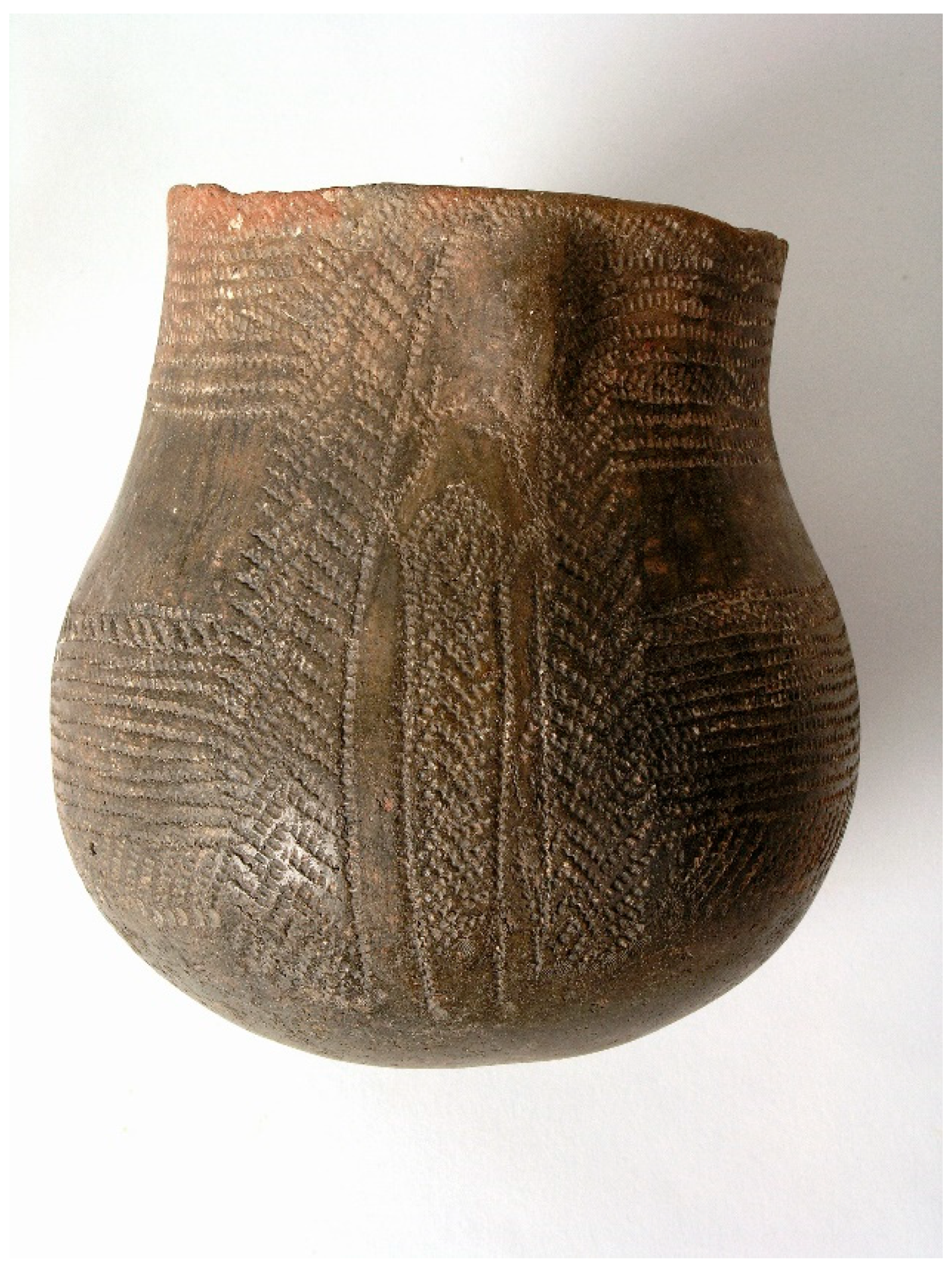
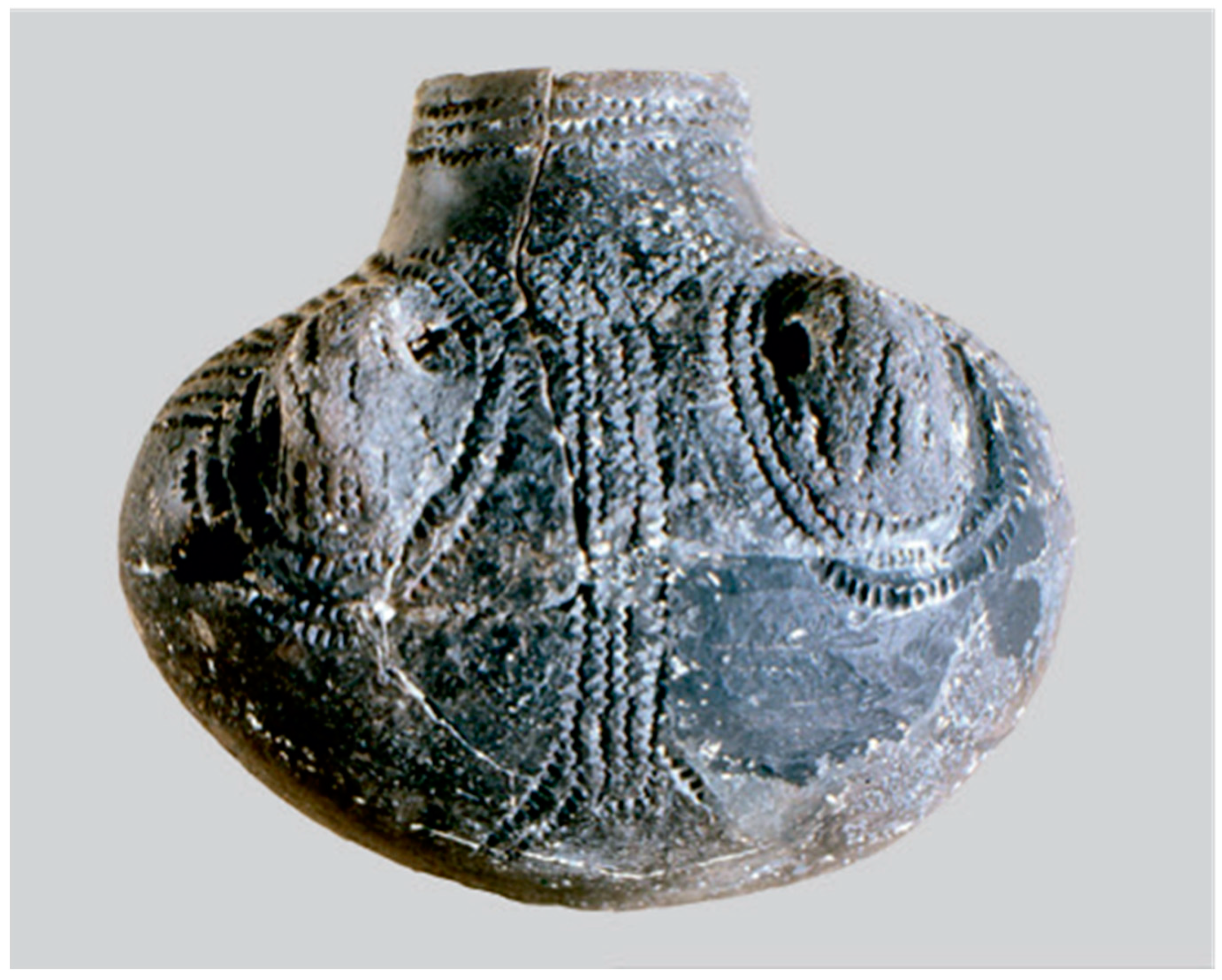

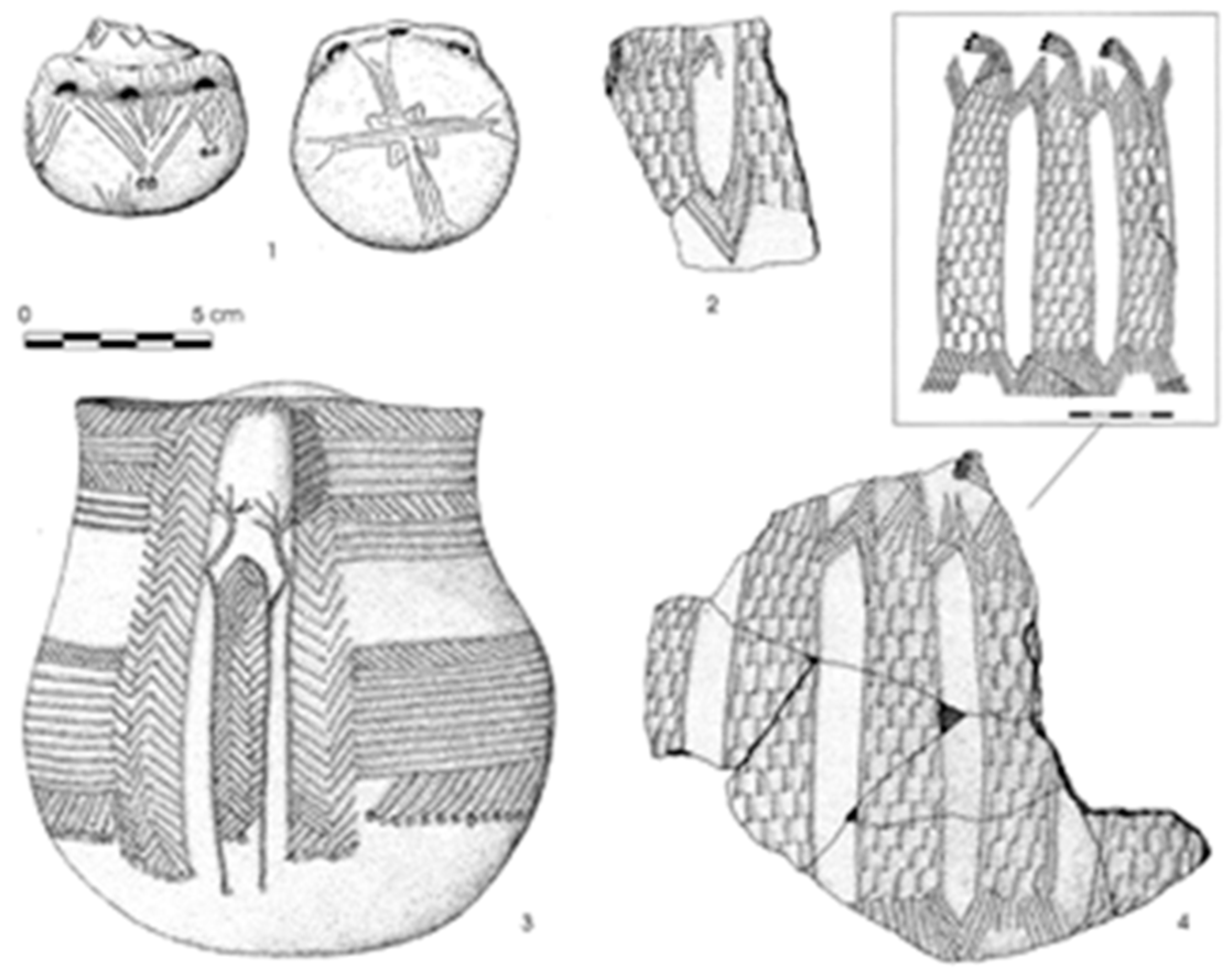

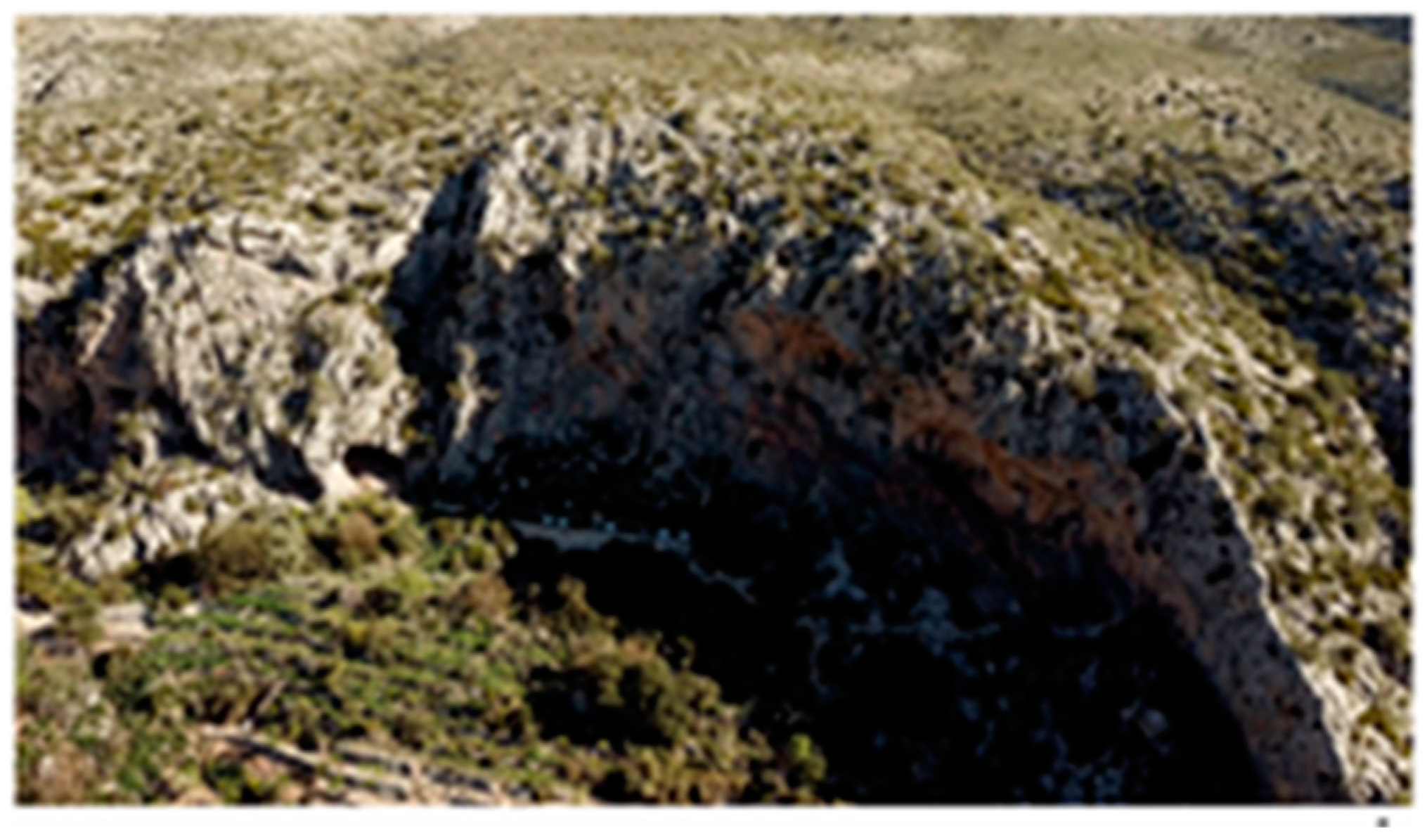
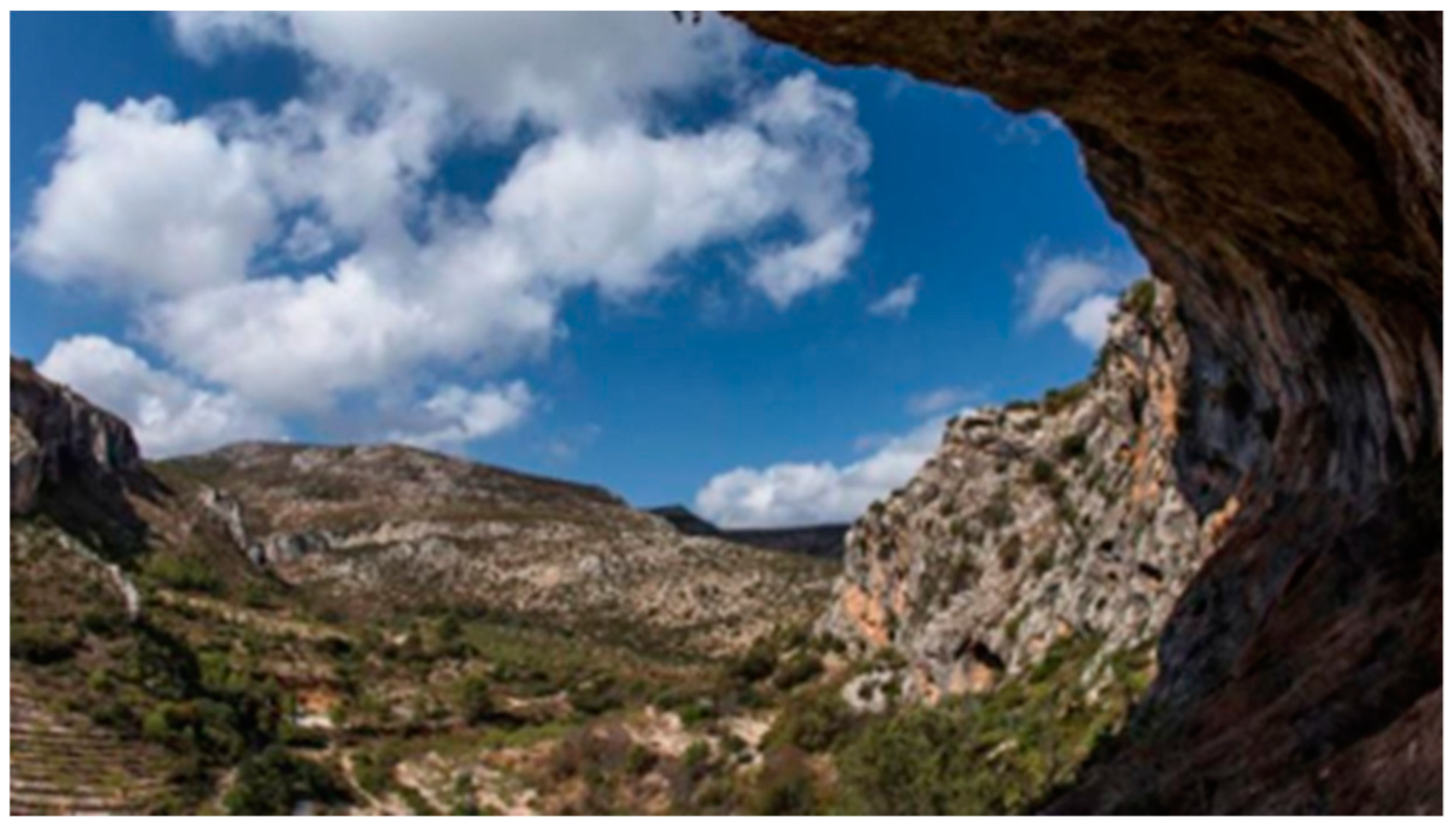
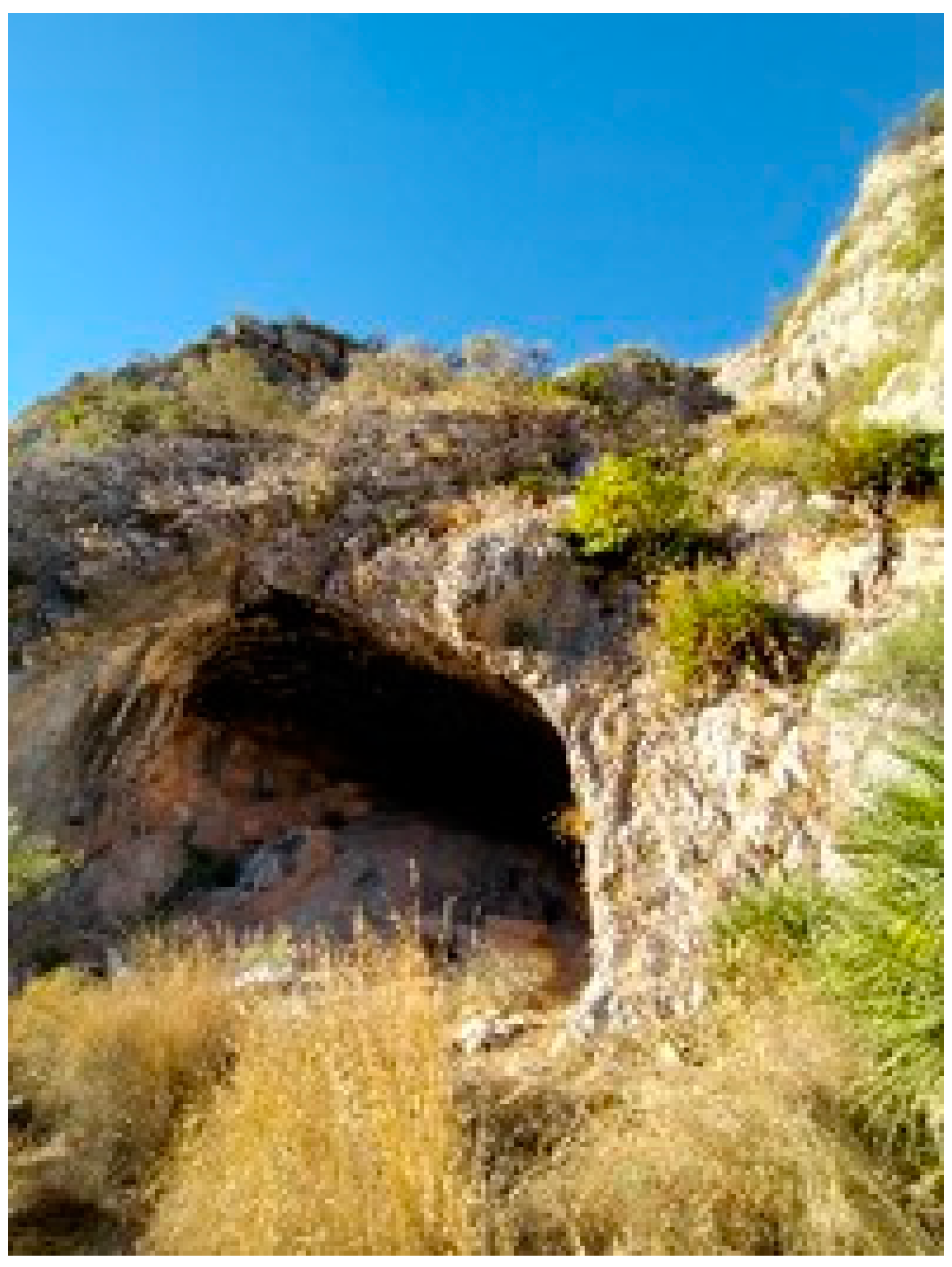
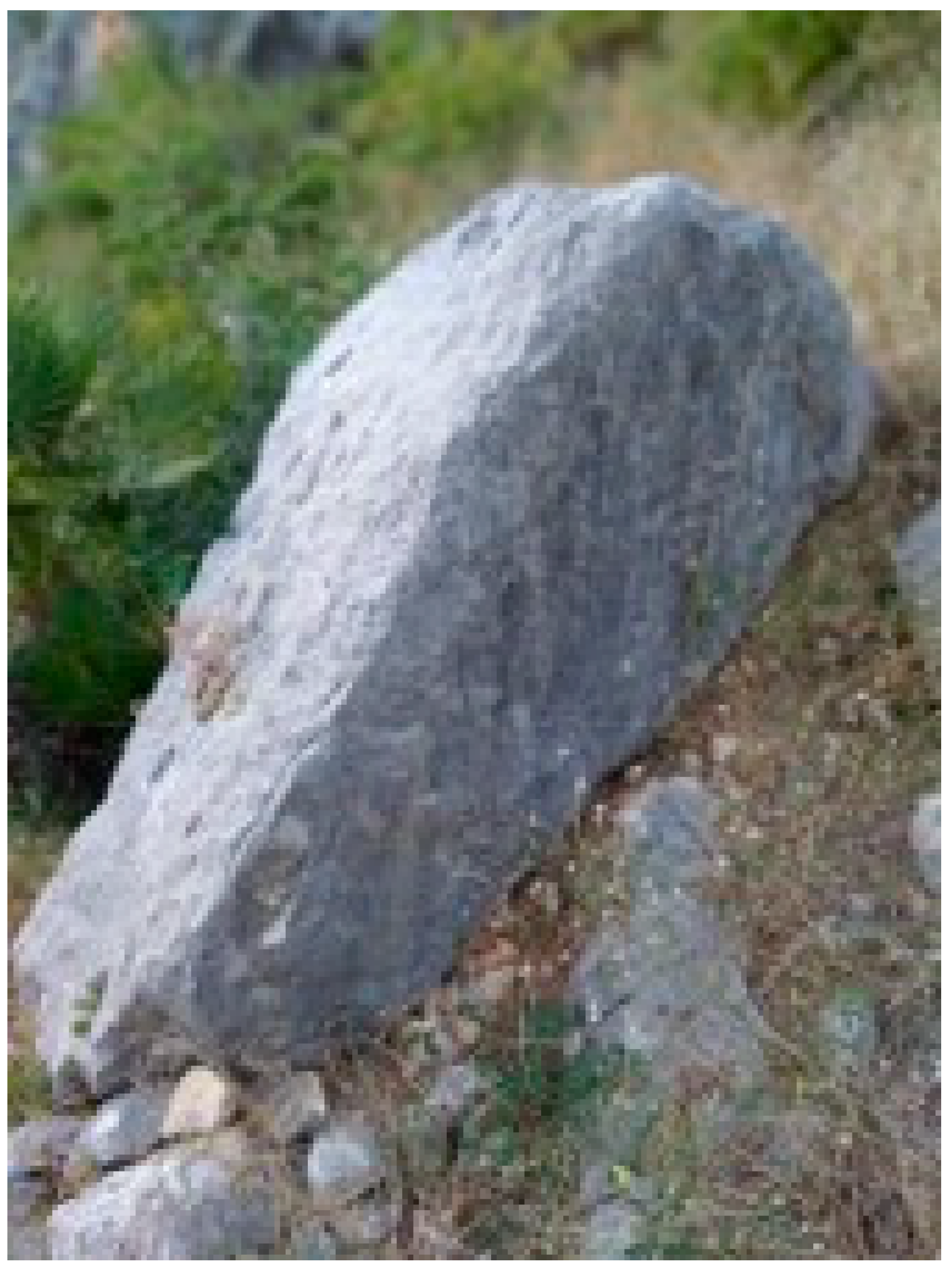
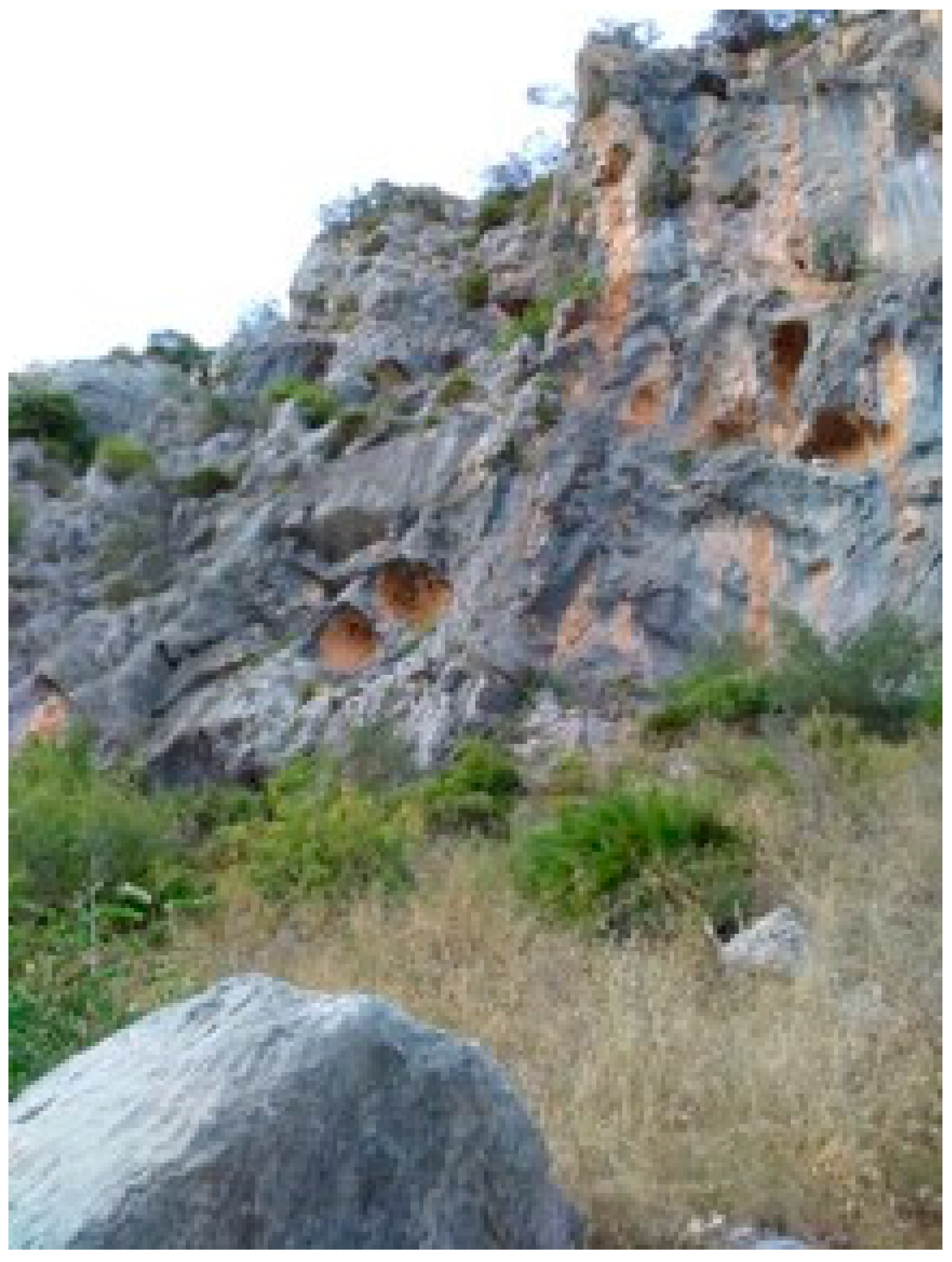
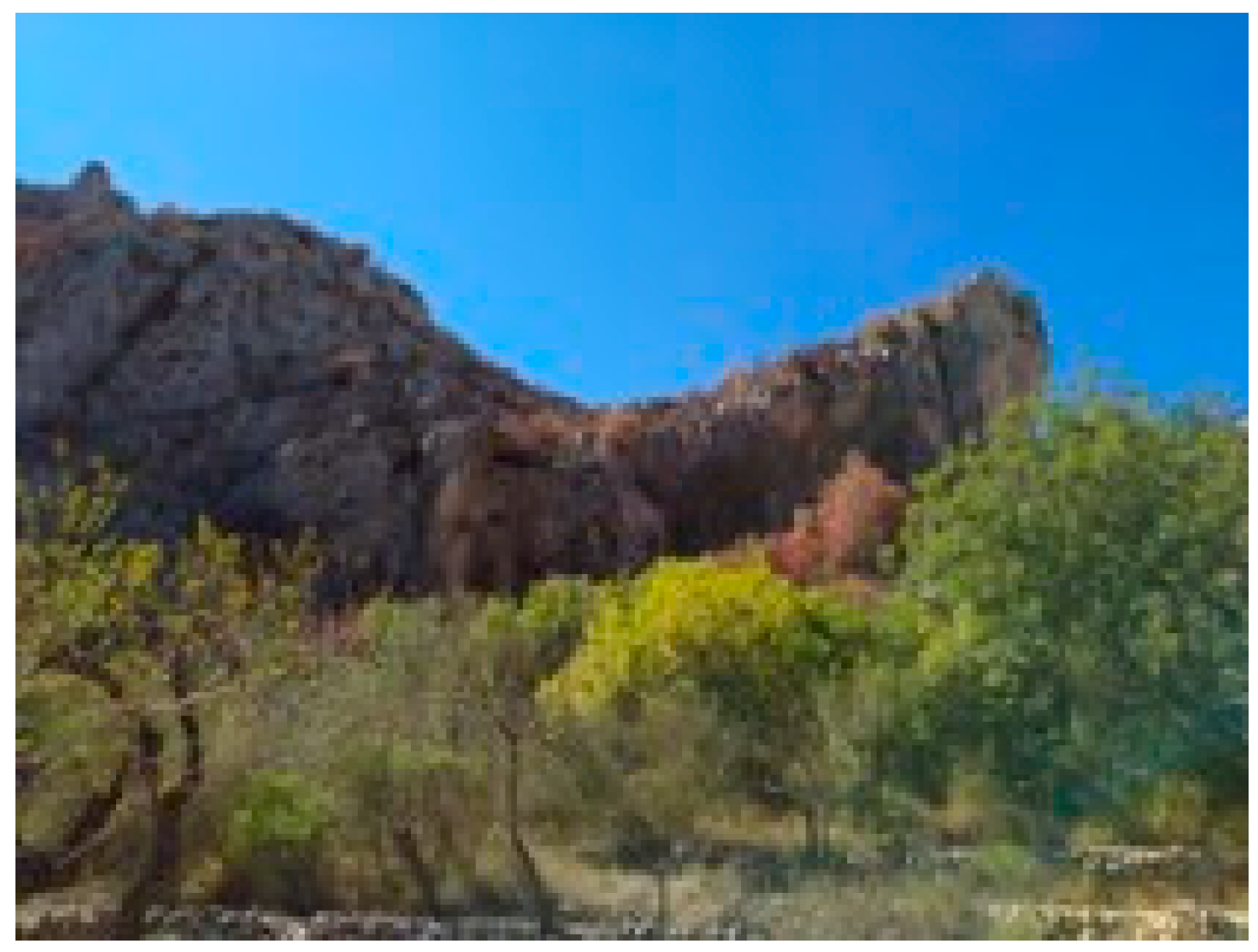



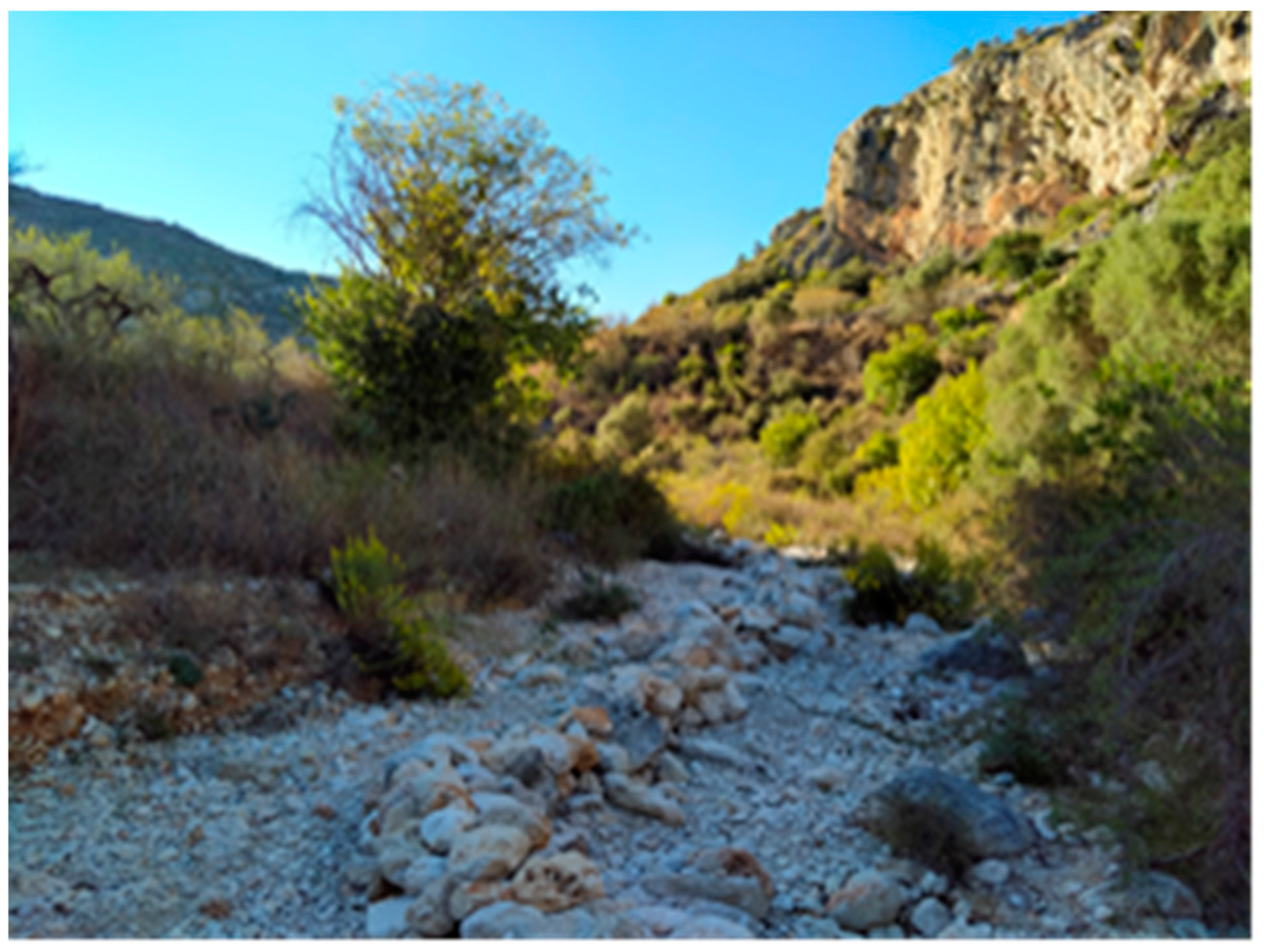
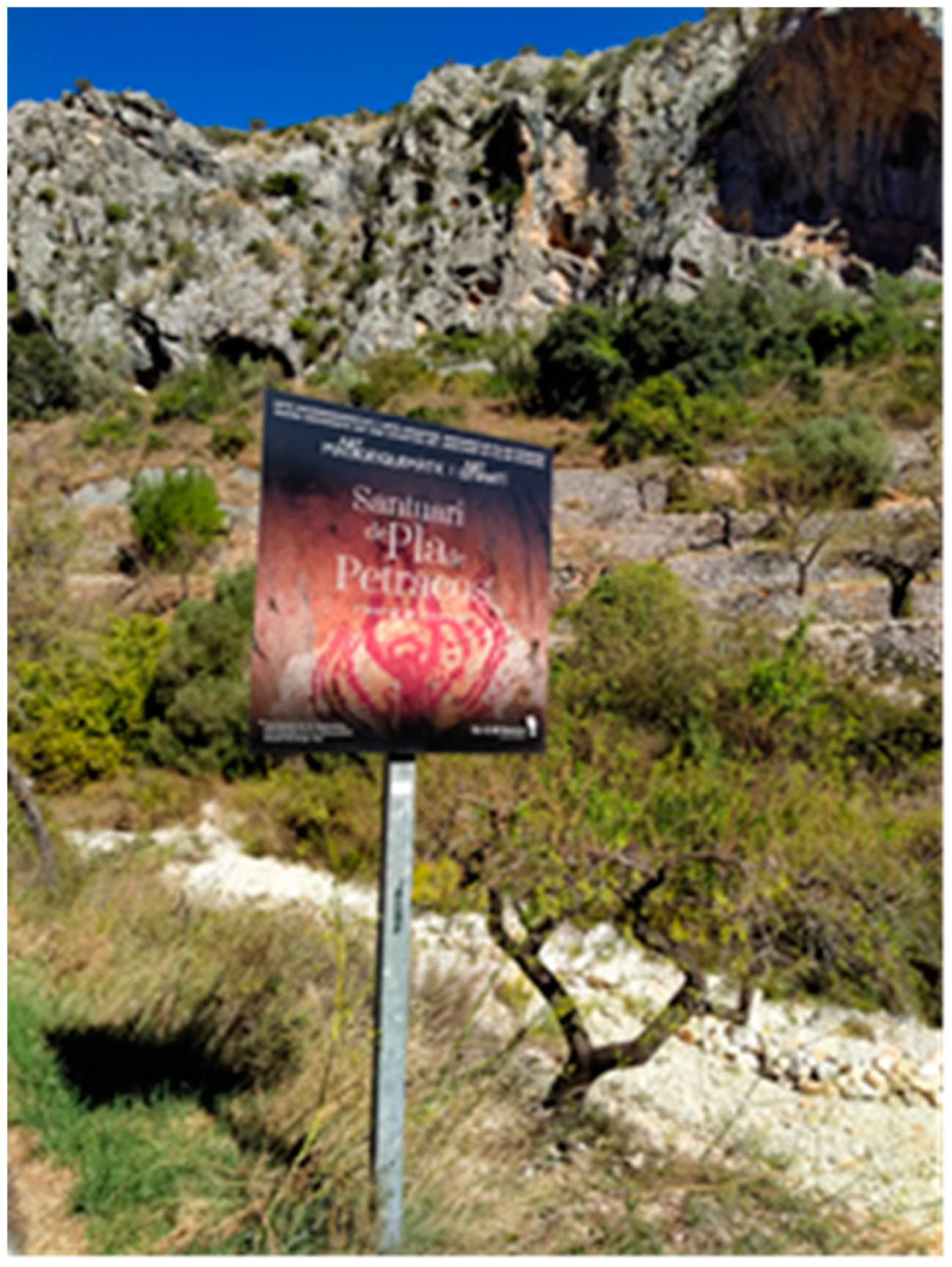
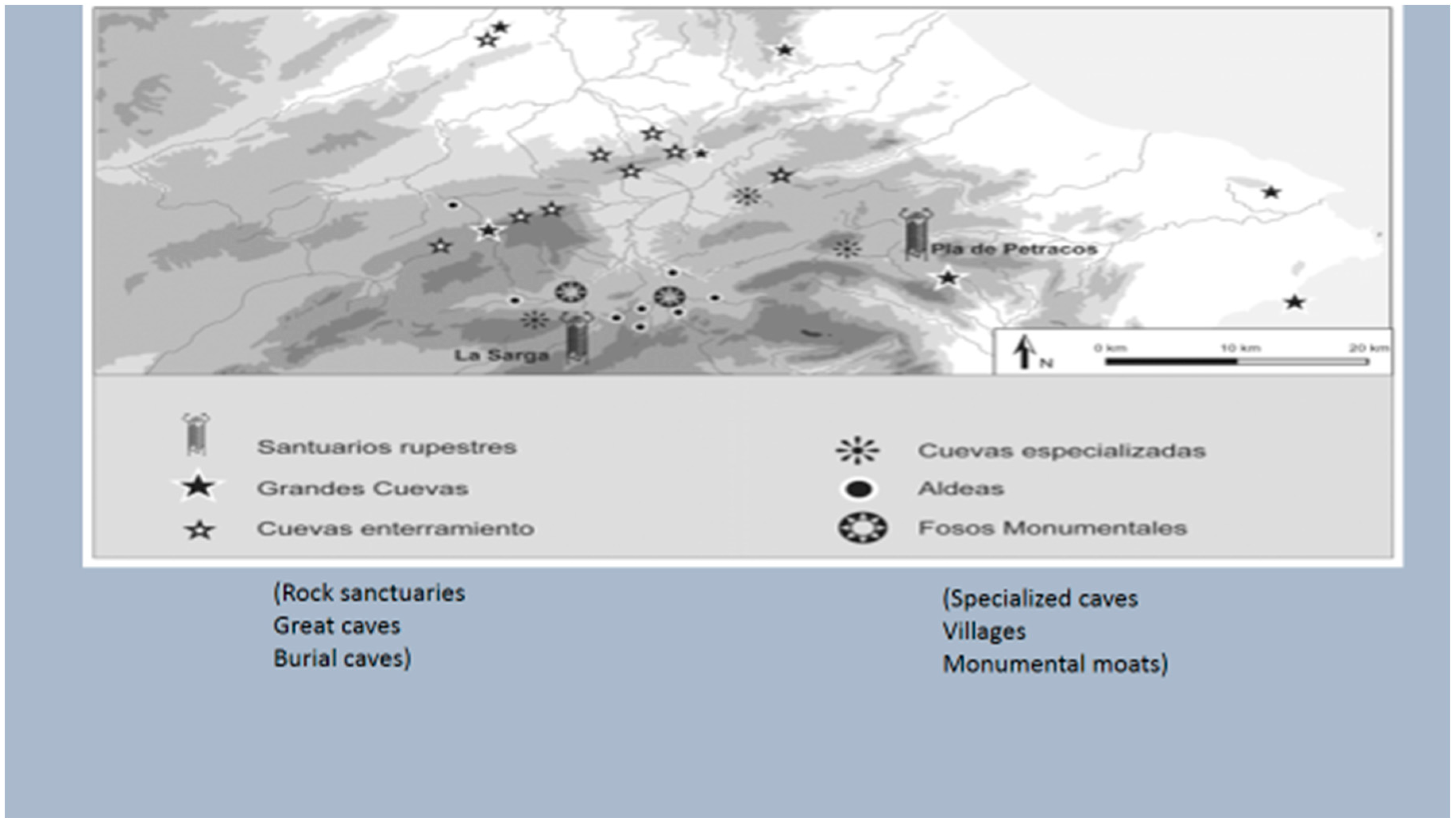
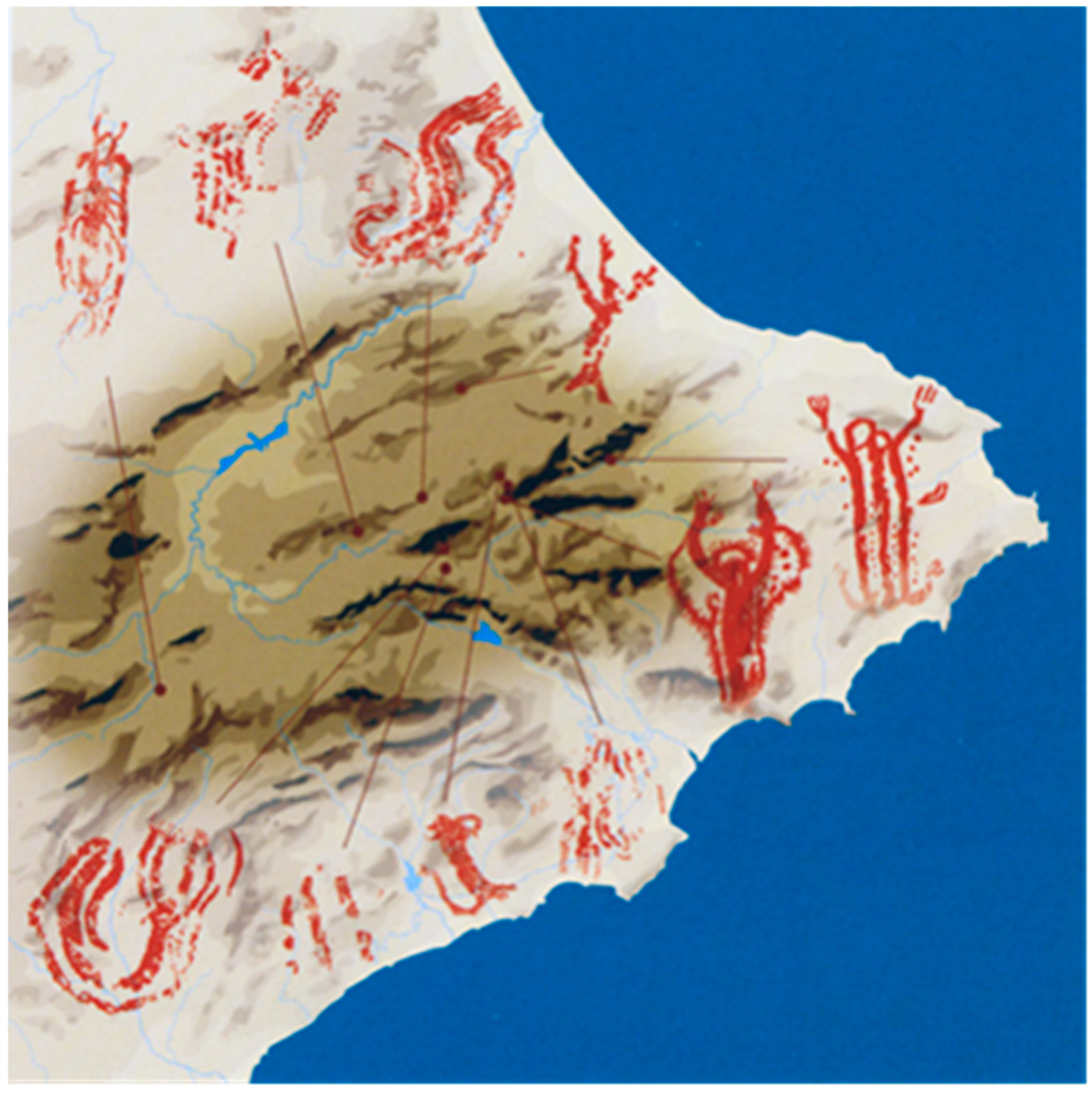

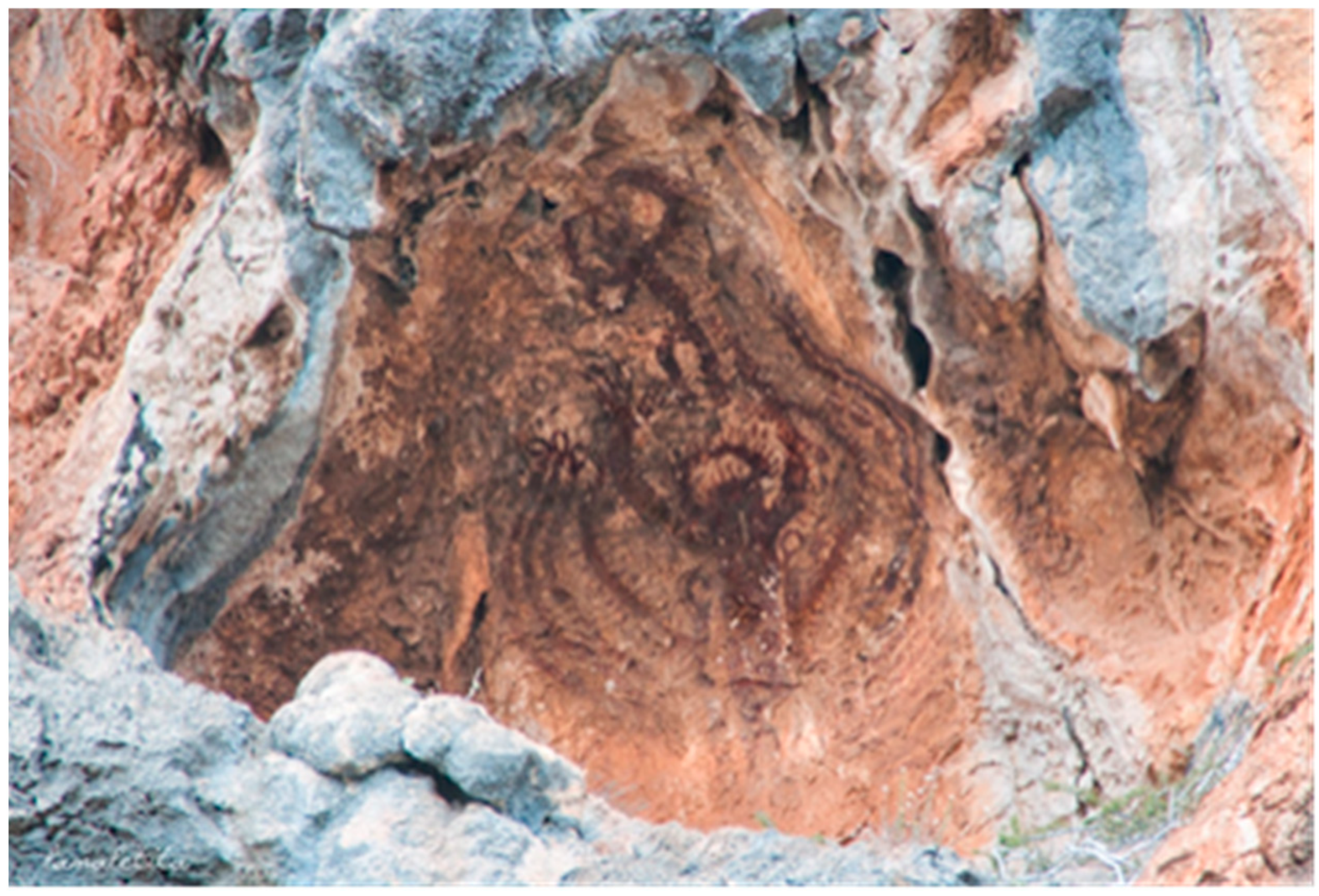
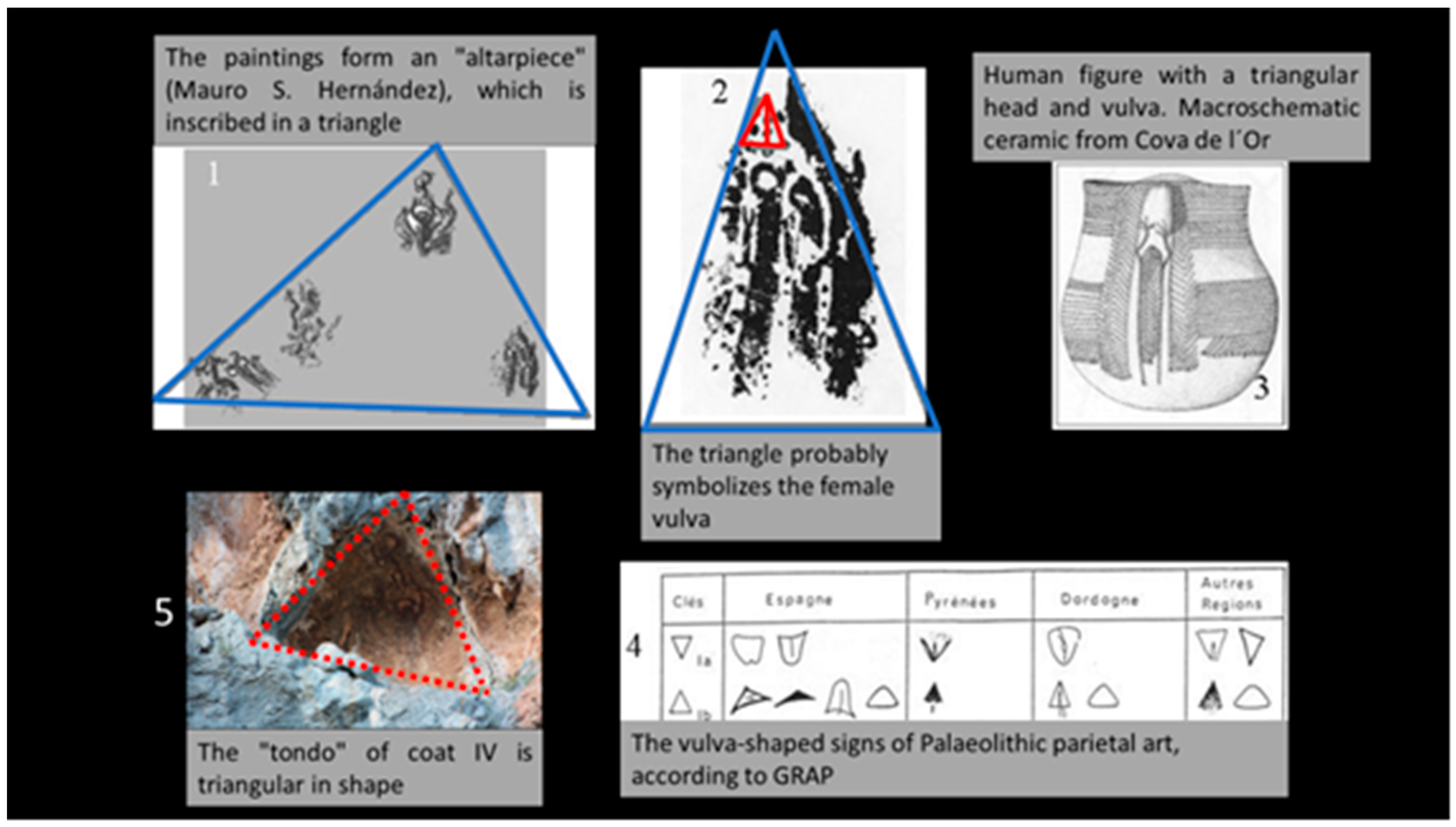
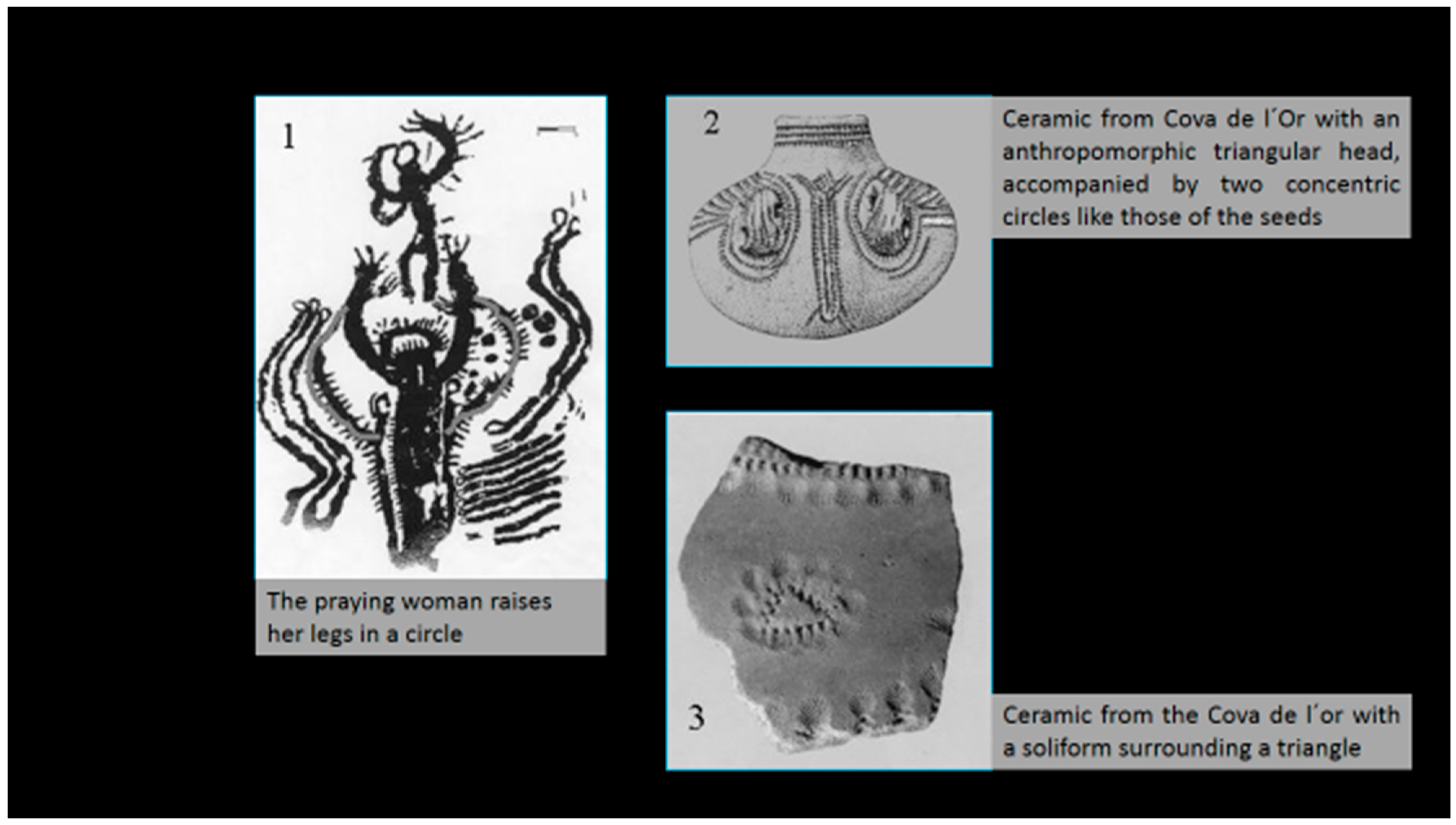
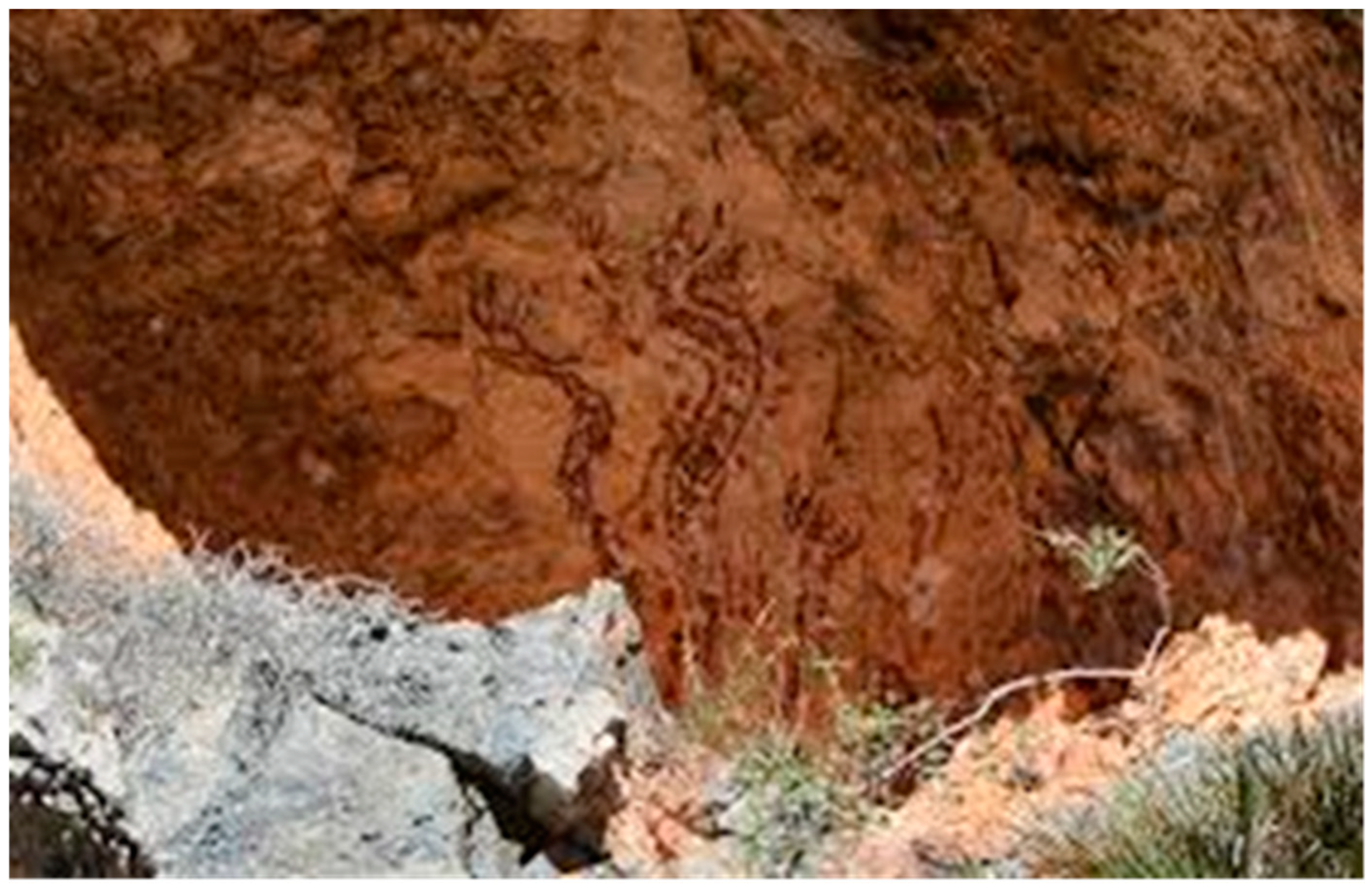
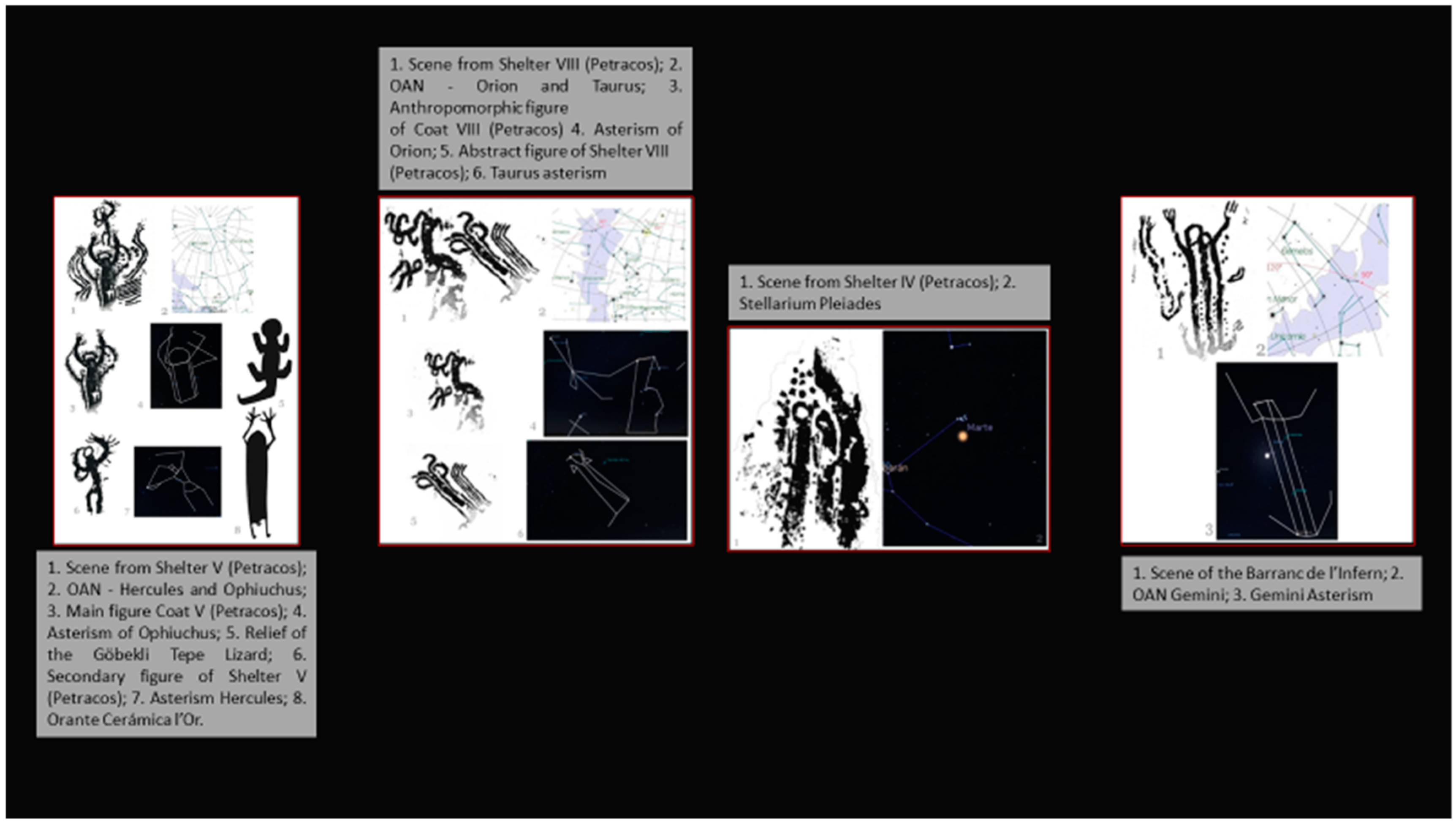
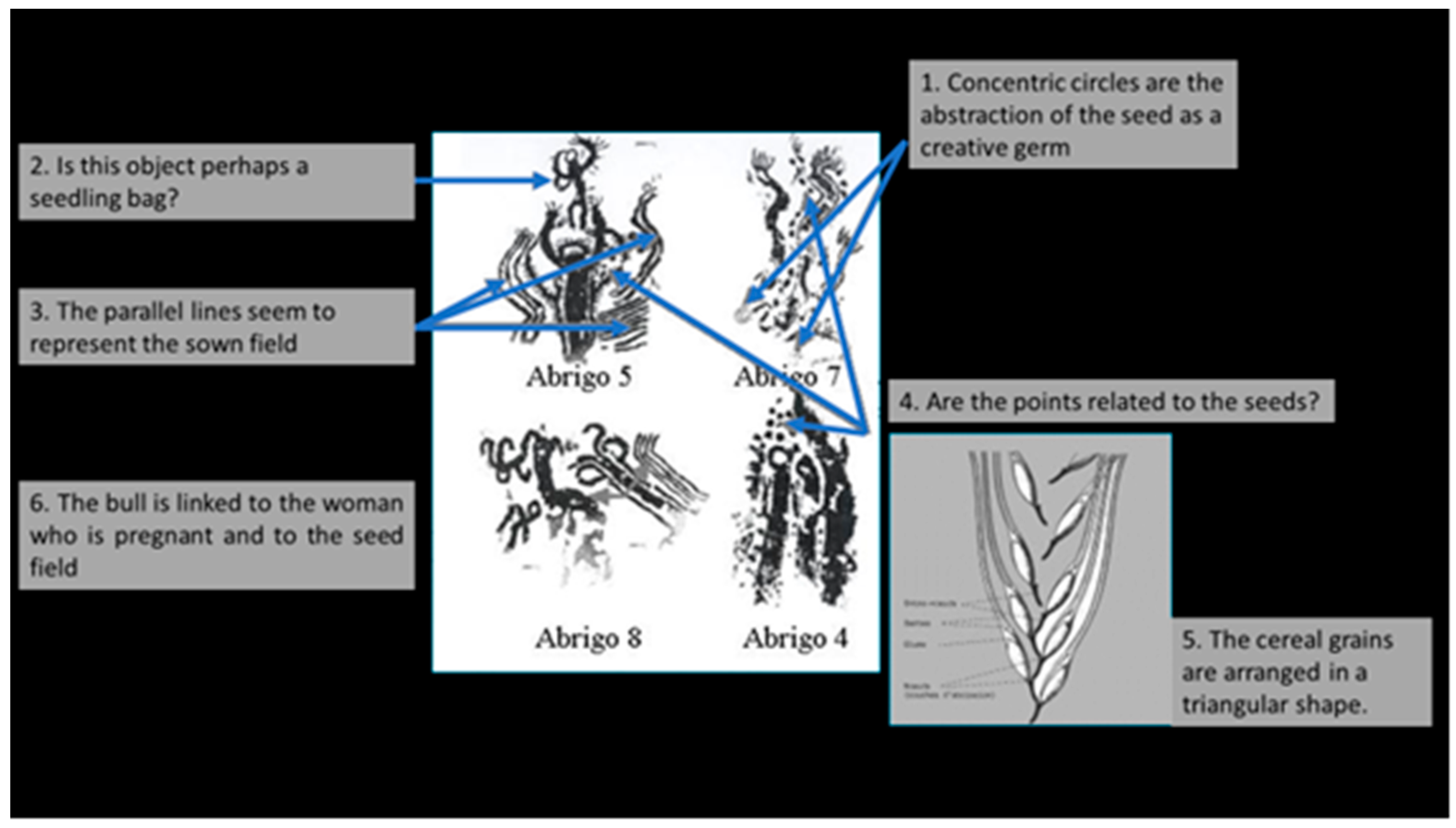
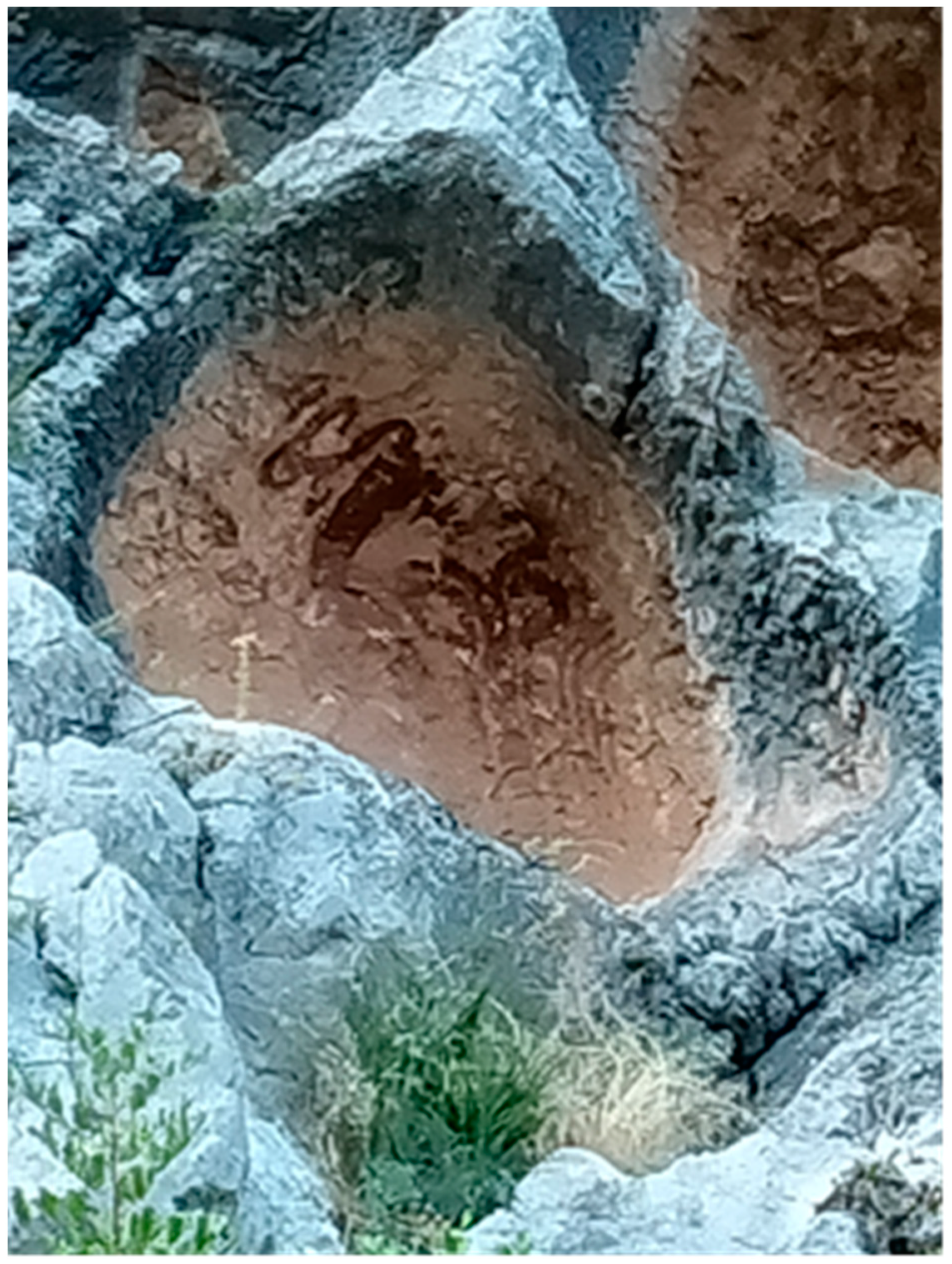


Publisher’s Note: MDPI stays neutral with regard to jurisdictional claims in published maps and institutional affiliations. |
© 2020 by the author. Licensee MDPI, Basel, Switzerland. This article is an open access article distributed under the terms and conditions of the Creative Commons Attribution (CC BY) license (http://creativecommons.org/licenses/by/4.0/).
Share and Cite
Roche Cárcel, J.A. Images of the Mother Goddess in the Neolithic Sanctuary of Pla de Petracos (Alicante, Spain)—The Sacralization of Agriculture. Religions 2020, 11, 614. https://doi.org/10.3390/rel11110614
Roche Cárcel JA. Images of the Mother Goddess in the Neolithic Sanctuary of Pla de Petracos (Alicante, Spain)—The Sacralization of Agriculture. Religions. 2020; 11(11):614. https://doi.org/10.3390/rel11110614
Chicago/Turabian StyleRoche Cárcel, Juan Antonio. 2020. "Images of the Mother Goddess in the Neolithic Sanctuary of Pla de Petracos (Alicante, Spain)—The Sacralization of Agriculture" Religions 11, no. 11: 614. https://doi.org/10.3390/rel11110614
APA StyleRoche Cárcel, J. A. (2020). Images of the Mother Goddess in the Neolithic Sanctuary of Pla de Petracos (Alicante, Spain)—The Sacralization of Agriculture. Religions, 11(11), 614. https://doi.org/10.3390/rel11110614



